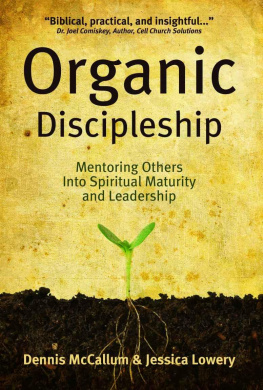ZONDERVAN
T HE L OST A RT OF D ISCIPLE M AKING
Copyright 1978 by LeRoy Eims
All rights reserved under International and Pan-American Copyright Conventions. By payment of the required fees, you have been granted the non-exclusive, non-transferable right to access and read the text of this e-book on-screen. No part of this text may be reproduced, transmitted, down-loaded, decompiled, reverse engineered, or stored in or introduced into any information storage and retrieval system, in any form or by any means, whether electronic or mechanical, now known or hereinafter invented, without the express written permission of Zondervan.
EPub Edition June 2009 ISBN : 978-0-310-83206-5
Requests for information should be addressed to:
Zondervan Publishing House
Grand Rapids, Michigan 49530
Library of Congress Cataloging in Publication Data
Eims, LeRoy.
The lost art of disciple making.
Bibliography: p.
1. Christian life1960- 2. Christian leadership.
I. Title.
BV4501.2.E32 248'.4 78-17227
ISBN 0-310-37281-X
All quotations from the Old Testament, unless otherwise indicated, are from the New American Standard Bible, The Lockman Foundation, 1960, 1962, 1963, 1968, 1971, 1972, 1973, 1975. Used by permission.
All scripture quotations, unless otherwise noted, are taken from the HOLY BIBLE: NEW INTERNATIONAL VERSION (North American Edition). Copyright 1973, 1978, 1984, by The International Bible Society. Used by permission of Zondervan Bible Publishers.
06 07 08 09 10 60 59 58 57 56 55 54 53 52 51
Information about External Hyperlinks in this ebook
Please note that footnotes in this ebook may contain hyperlinks to external websites as part of bibliographic citations. These hyperlinks have not been activated by the publisher, who cannot verify the accuracy of these links beyond the date of publication.
To
Dr. Clyde W. Taylor
a man mightily used of God around the globein seeing spiritually qualified laborersraised up to the glory of God
Jesus came to save the world, and to that end He died, but on His way to the cross He concentrated His life on making a few disciples. These men were taught to do the same, until through the process of reproduction, the gospel of the kingdom would reach to the ends of the earth.
The way Gods Son lived thus became a pattern to all who follow in His stepsa principle explicated clearly in the command to make disciples of all nations. How they are made, of course, will be conditioned on particular gifts and roles in society, but everyone who believes on Christ is called to His work within his own vocation and life-style.
Unfortunately, few Christians seem to understand what this means, at least when it comes to daily living. Even persons who are in leadership positions of the church often have no idea how to go about teaching others to observe all things that Jesus commanded. Where this pertains it is not surprising that believers fail to go very far in their pilgrimage of faith, much less develop the potential of their ministry.
That is why this volume is such a pleasure to commend. It comes to grips with the real work of discipling men, not in vague institutional programs, but in clear guidelines for personal initiative. The treatment is simple and to the point. Our Lords mandate need not be a lost art to those who will take to heart the counsel found in these pages.
Giving authenticity to the book, while enhancing its down-to-earth appeal, is the authors own experience. LeRoy Eims writes as a practitioner, not a theoretician. For years he has been actively involved in shaping the lives of men. There are scores of persons today in harvest fields around the world who bear witness to his faithful labors with them.
His approach reflects the strategy of The Navigators where he serves as International Ministry Representative. But what he says is not the property of any organization. This is basic New Testament discipleship. Anyone can profit from its reading. Best of all, the application of its truth can bring new meaning and excitement into livingliving in the fulfillment of the great commission.
R OBERT E. C OLEMAN
Asbury Theological Seminary
When my daughter Becky was in grade school, we often took walks together. We would stroll among the towering pine trees, the scrub oak, and various plants and flowers in a beautiful area near our home. One day we had a conversation about a scrawny little bush that was growing along our path. I explained to Becky that we should be proud of that little bush, because even though it wasnt nearly as big as the magnificent blue spruce growing nearby, it had grown to its maximum potential. It was as fully developed as it could be with the amount of rain and sunshine it had obtained. It had not held back; it had grown to its limit.
Babies are somewhat like that too. They will grow if someone will help a little. They are only too happy to eat if someone will but put milk in the bottle or take the cap off the jar of strained peas and spoon them in.
Now that Becky has grown up, married, and had a child of her own, I watch with amazement as she feeds her daughter. When little Joy Elise sees the food, it prompts all the excitement of a circus coming to town. All we have to do is get the food within her reach and Joy will do the rest.
Every believer in Jesus Christ deserves the opportunity of personal nurture and development. Every new believer is expected to achieve his or her full potential for God. And most of them would if they had the opportunity, if someone would get the food within reach, if someone would give them the help they need, if someone would give them the training they should have, and if someone would care enough to suffer a little, sacrifice a little, and pray a lot.
In this book we want to look at the growth process in the life of a Christian, from the time that person comes to Christ to his or her becoming a disciple and then a worker for Him. We will examine what nurture and guidance it takes to develop spiritually qualified workers in the church of Jesus Christ.
The concepts and principles we will be suggesting and examining do not emerge from a philosophy of speedy growth and instant maturity. True growth takes time and tears and love and patience. On the leaders part, it takes the faith to see people as God expects them to be and wants them to become. And it takes some knowledge to help get them there.
This book does not pretend to be the entire chain in the training process; it does not presume to contain all the answers to the problems of spiritual growth. In fact, it does not even presume to have many answers to many problems. What it does try to do is provide some information to help Christian leaders strengthen one small link in the entire chain of their ministry for Christ. It is not the whole chain. It deals only with one link: how to train spiritually qualified workers for Christ.
The book is based on a study of the Word of God and the experience of many in an organization committed to making disciples and helping produce workers for the cause of Christ. It is sent out with the prayer that the Holy Spirit will use it to strengthen a weak link here and there, thus helping Christians to be better equipped and more effective in their service for the Lord.
L EROY E IMS
Colorado Springs, Colorado











